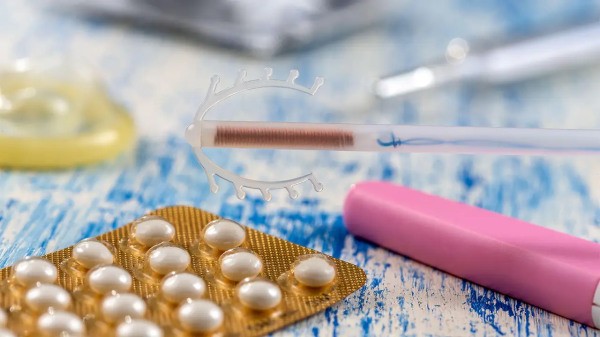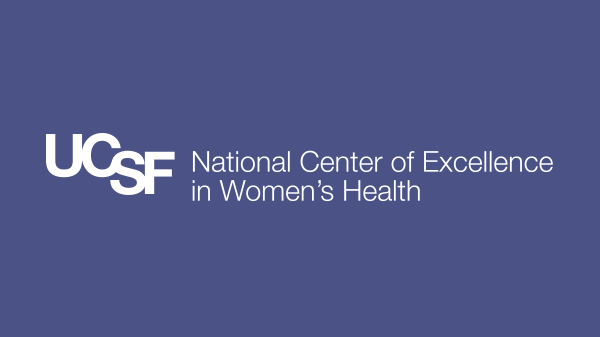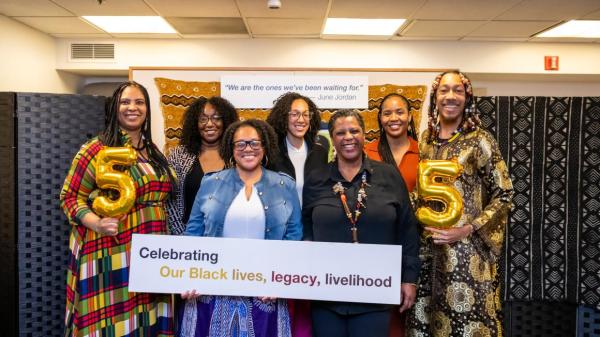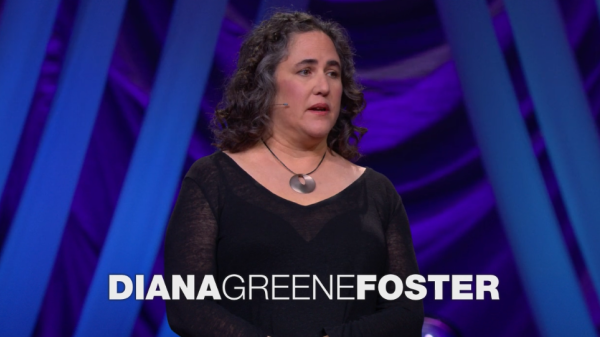Study Highlights Urgent Need for Access to Rapid Testing to Shorten Delays Between Infection, Test Results and Isolation, Researchers Say
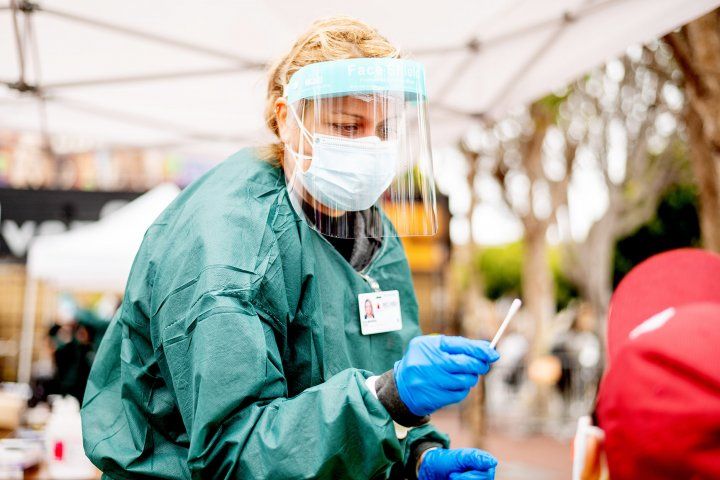
Nurse Elia Moreno administers a COVID-19 test at the 24th Street Mission BART Plaza transit hub on July 29. Photo by Noah Berger
Low-income Latinx essential workers affected by San Francisco’s housing crunch continue to be disproportionately impacted by COVID-19, according to data from a three-week testing initiative conducted in San Francisco’s Mission District at the beginning of August.
The initiative was led by Unidos En Salud, a collaboration between UC San Francisco and the Latino Task Force on COVID-19. In an April study. Unidos En Salud identified the outsized exposure risk facing Latinx essential workers and their families in the Mission, driven in part by inequalities in economic and housing security. Their new study shows continued unmet demand for access to testing and the value of locating low-barrier testing at a central transit hub – believed to be the first such program in the nation.
The initiative tested 2,622 people at the busy 24th Street Mission BART Plaza in six half-day sessions – at an average rate of 100 tests per hour. Overall, 9 percent (235) of the PCR-based tests came back positive for SARS-CoV-2 infection, with a test positivity rate of 11 percent among Latinx participants. San Francisco’s overall test positivity rate is currently 2.61 percent, according to the Department of Public Health. The vast majority of those who tested positive at the transit hub site are Latinx (93 percent), speak Spanish as their preferred language (85 percent), earn incomes of less than 50,000 a year (87 percent), and live in high-density households (79 percent). People from across the Bay Area were tested at the plaza, but most positive results were seen in residents of the Mission or southeast San Francisco.
Analysis of the amount of virus being shed by individuals who tested positive – conducted by collaborators at the Chan Zuckerberg Biohub – showed that about half (48 percent) had the high levels of virus indicative of the most infectious stage of the disease. However, virtually all reported regularly wearing a mask when in public (98 percent) and using hand sanitizer (92 percent).
Project leaders emphasize that the test results do not reflect a representative sample of Mission residents or public transit riders in general. Because the study was open to all, it likely over-counts individuals who wanted to get tested because they thought they might be sick. For example, nearly everyone who tested positive was symptomatic (92 percent), likely because asymptomatic people are less likely to get tested.
“Seven months into this pandemic, low-income Latinx essential workers living in close-knit family units continue to be uniquely vulnerable,” said Diane Havlir, MD, chief of the UCSF Division of HIV, Infectious Diseases and Global Medicine at Zuckerberg San Francisco General Hospital and Trauma Center (ZSFG) and co-founder of Unidos en Salud. At the same time, these groups experience significant barriers to testing, study leaders said, including inability to take time off work, lack of access to medical systems, and fear of a positive test potentially putting income, job security and perhaps immigration status at risk.
To reduce barriers to access, the new initiative provided free testing to all comers, with no requirement for preregistration, identification or insurance. The location at the central 24th Mission BART plaza – a hub for Bay Area Rapid Transit District (BART) trains and San Francisco Muni buses – made testing easily accessible to commuting workers as well as to local merchants and transit employees, who received VIP cards for fast-track testing. Those who tested positive were connected with resources to support isolation by community-based care teams.
“We show that low-barrier testing at a central transit hub is a highly effective way to reach essential workers and other vulnerable groups,” Havlir said. “Our data also further demonstrate the need to provide infected individuals with rapid results and social support so they can go into isolation to avoid infecting their families and other contacts.”
The initiative was conducted in partnership with BART, the office of San Francisco Supervisor Hillary Ronen, the San Francisco Department of Public Health (SFDPH), and the Chan Zuckerberg Biohub.
“This important research reinforces our collective work to make testing more accessible to priority populations and helps inform efforts to assist these communities,” said Grant Colfax, MD, San Francisco Director of Health. “In addition to expanding low barrier testing in neighborhoods with high rates of COVID-19, increasing the capacity of contact tracing teams, and continuing to offer isolation and quarantine rooms to people in need, we must continue to expand investments in our COVID-19 response, including in the Latinx community. I am grateful for UCSF's partnership and focus on following the path of the virus through the community and improving our COVID-19 prevention and response efforts in the City as a whole.”
Results Highlight Delays Between Infection, Testing, Isolation
The results also highlight an urgent need to reduce delays between initial infection, testing, and isolation if public health efforts are to stem the continued spread of SARS-CoV-2, the investigators say. People with COVID-19 are most infectious beginning a couple days before they begin experiencing symptoms to around five days after. However, interviews with those tested at 24th St. Mission Plaza found that it took an average of five days from first symptoms until people who tested positive were able to go into isolation.
“Public health advice is to go into isolation for 10 days following the first symptoms, but if it takes almost a week from the time of infection to go into isolation, most of the harm has already been done,” said Carina Marquez, MD, assistant professor in the UCSF Division of HIV, Infectious Diseases, and Global Medicine and co-director of the testing initiative. “This emphasizes the need for rapid, highly accessible testing, particularly in areas where we know the virus is still spreading, as well as more education and social support to allow people to go into isolation right away.”
Less than one quarter of people who tested positive (22 percent) reported having access to any type of formal sick leave, and many asked to be referred to San Francisco’s Right to Recover program to receive financial support for taking time from work and going into isolation. The city estimates the funds will not be available until mid-September.
“We hear from people all the time who don’t have the privilege to take time off to get tested when they first notice symptoms, or aren’t able to take time off work or make rent in order to go into isolation,” added Jon Jacobo, chair of the health committee for the Latino Task Force. “As a result, this virus is still spreading rapidly through our community. It’s outrageous that we’re still experiencing this level of neglect seven months into the pandemic. We need direct and meaningful action, and we need it now.”
Concerningly, one in 10 of those who tested positive were following up on a past positive test result in order to be able to go back to work. It is not legal in San Francisco for employers to require workers to demonstrate a negative PCR result, as long as they have gone through the recommended period of isolation, because tests may continue to come back positive long after someone ceases to pose an infection risk. To reinforce this, San Francisco Health Officer Tomas Aragon, MD, DrPh, has issued a letter to all San Francisco employers, discouraging them from requiring a medical notes for clearance to return to work after an employee has COVID-19.
The Unidos En Salud initiative is part of the recently launched UCSF COVID-19 Community Public Health Initiative. Led by Kirsten Bibbins-Domingo, PhD, MD, MAS, vice dean for population health and health equity at the UCSF School of Medicine, the initiative focuses on communities and populations disproportionately affected by the virus, and on building durable community partnerships.
In addition to COVID-19 testing, UCSF’s closely coordinated response to COVID-19 with the City and County of San Francisco, other Bay Area communities, and the state of California has included providing forecasts about the pandemic across the state and advice and counsel on pandemic response by UCSF epidemiologists; implementing a statewide contact tracing program in collaboration with the California Department of Health; providing $1 million and clinical expertise for the City to open a COVID-19 unit at Saint Francis Memorial Hospital; and opening a new, 53-bed respiratory isolation unit at UCSF Health’s Mount Zion hospital to expand the city’s overall hospital capacity for potential future surges, while offering dedicated space for current patients.
The proactive effort builds on UCSF’s long-standing commitment to addressing public health crises, which dates back to the University's founding in the mid-19th century, and includes such issues as homelessness, and such diseases as cholera, tuberculosis and HIV/AIDS.
The University of California, San Francisco (UCSF) is exclusively focused on the health sciences and is dedicated to promoting health worldwide through advanced biomedical research, graduate-level education in the life sciences and health professions, and excellence in patient care. UCSF Health, which serves as UCSF’s primary academic medical center, includes top-ranked specialty hospitals and other clinical programs, and has affiliations throughout the Bay Area.

